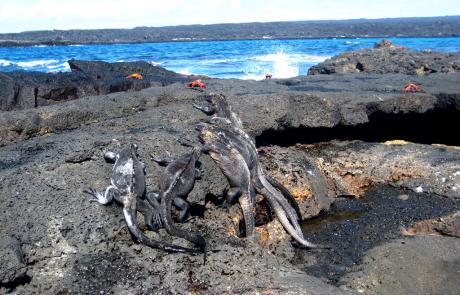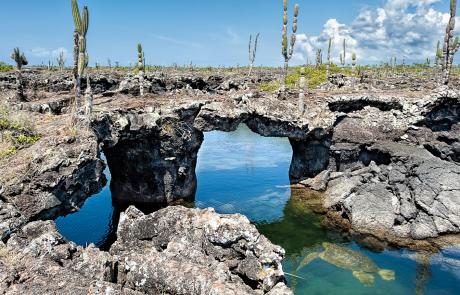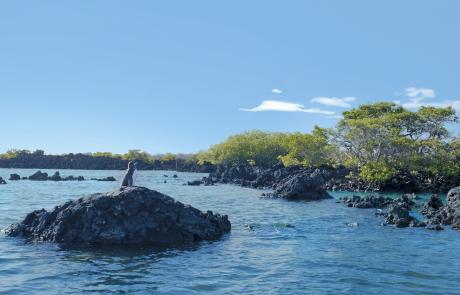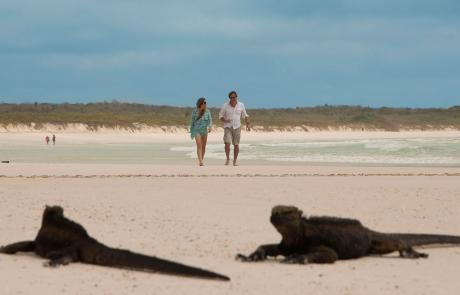Isabela Island, Galapagos
Overview
Step foot onto Isabela, by far the biggest island in the Galapagos, where travelers can get a front-row seat to nature, with gorgeous beaches, startlingly diverse wildlife, and sweeping volcanic landscapes.
With a larger area than all the other Galapagos islands combined, Isabela extends 4,586 square kilometers (1,771 square miles) in the western region of the archipelago. It’s the second youngest islands in the archipelago, formed about 1 million years ago, with the merging of six different volcanoes: Ecuador, Wolf, Darwin, Alcedo, Sierra Negra, and Cerro Azul which merged to create the spectacular seahorse-shaped Island. To this day, all except for Ecuador Volcano remain active, making Isabela one of the most volcanically active destinations on the planet.
Despite arid volcanic regions that consist largely of lava fields and very little vegetation, the rest of the island is lush and vibrant. With palm-fringed beaches, lagoons teeming with pink flamingos, dazzling underwater life, and misty volcanoes and calderas, Isla Isabela is a true idyll that deserves a spot on every Galapagos adventurer’s bucket list.
Key Visitor Points
Puerto Villamil
Set on the southern coast of Isabela, the sleepy port town of Puerto Villamil where most of Isabela’s 2,200 inhabitants live. It’s an inviting base for travelers, with pristine expansive white-sand beaches dotted with marine iguanas and sea lions, picturesque lagoons frequented by pink flamingoes, nearby snorkelling and diving hot spots, and a handful of traveler accommodations. Drop by the Tortoise Breeding Center to meet the dino-like creatures and to learn about the different tortoise species found in the various volcanic areas in Isabela. Travelers can also swim and snorkel in the calm waters of Concha de Perla, where penguins, turtles, sea lions, and a wide variety of birds are spotted daily.
Flamingos Lake
The lakes and lagoons west of Puerto Villamil are home to the largest concentration of flamingos in the Galapagos. Wildlife lovers who want to see a flamboyance of these bright pink birds, these lagoons are just a short walk behind town and worth a visit.
Wall of Tears
Few places in the Galapagos Islands put human history in the spotlight, but the Wall of Tears is one of these little-known relics to a very dark period in Galapageño and Ecuadorian history. Built by prisoners of the former penal colony on Isabela, this 20-meter (65-foot) high wall served no purpose other than as labor and punishment for the prisoners. Found on 4 kilometer (2.5 mile) dirt and sand path outside of Puerto Villamil, the Wall of Tears is an amazing side trip for travelers on a land-based tour. Expect about an hour-long bike ride to this historic site, with the path passing by scenic beaches, the idyllic Estero and hikes to lookout points.
Las Tintoreras
A group of tiny islets just a few minutes boat ride off the coast of Puerto Villamil, Las Tintoreras is a popular attraction named after the white-tip sharks locally known as tintoreras. Besides sharks, the crystalline waters around the islets are populated by Galapagos penguins, sea lions, sea turtles, rays, and a colorful collection of tropical fishes. One particular beach surrounded by mangroves in Tintoreras is one of the few rare nesting sites of marine iguanas in the Galapagos.
The Wetlands (Los Humedales)
The Wetlands is a 6-kilometer (3.7-mile) network of trails winding through swamps, lagoons, lakes, and mangrove forests in southern Isabela. Featuring a fantastic variety of flora and fauna, Los Humedales is ideal for birdwatching and wildlife viewing.
Los Tunneles
A 20 minute boat ride from Puerto Villamil brings you to one of the most amazing spots in all of the Galapagos Islands where partially collapsed lava tunnels create a paradise for white tipped sharks, green sea turtles, and myriad other marine species. Walk across the volcanic rock bridges formed by the collapsed lava tunnels as you watch a super highway of turtles and fish swim through the maze below.
Sierra Negra Volcano
Take a half day hike totaling about 10 kilometers (6 miles) to marvel at SIerra Negra Volcano, the second-biggest crater in the world, measuring 9 kilometers by 10 kilometers. The volcano rises 4,500 feet (1,372 meters) to the sky, and travelers can take a guided tour to the top to get a glimpse of the crater, old lava flows, and surrounding scenery. Many tours continue to Volcan Chico, a fissure that showcases more recent lava flows.
Moreno Point
Only accessible by a cruise and a panga ride which takes you to the rocky shores of Moreno Point, where Galapagos penguins and other vibrant shore birds are commonly seen. Follow trails on foot to explore several sparkling lagoons that boast an assortment of wildlife, especially birds like flamingoes, herons, and pelicans. Marine life in the tide pools includes green sea turtles and sharks.
Elizabeth Bay
Surrounded by mangroves and crystal-clear waters, and only accessible by a cruise, Elizabeth Bay is one of the places in Isabela that travelers can’t step foot on. Instead, the scenic bay can be enjoyed from a panga boat. Some of the archipelago’s most famous inhabitants live here, including the Galapagos penguins, flightless cormorants, lava herons, and marine iguanas. Dive underwater to swim with marine life, like rays, sea turtles, and other colorful fishes. Sailing past the rocky isles off the coast of Elizabeth Bay is typically part of the tour, with the nearby Mariela islets home to plenty of Galapagos penguins, too.
Urbina Bay
At the base of Alcedo Volcano lies Urbina Bay, where an uplift event in the 1950s pushed the seabed above the surface of the water and exposed the corals underneath. In this unique landscape, wildlife abounds. Here, cruise passengers can get a glimpse of the biggest land iguanas in Galapagos, along with flightless cormorants, Galapagos hawks, finches, and pelicans. Giant tortoises roam in their natural habitat, while sea turtles and rays are easy to spot while snorkeling.
Tagus Cove
Tagus Cove sits on the northwestern coast of Isabela, an old hideout of whalers and pirates who carved the names of their ships on the surrounding cliffs—graffiti that’s still visible to this day! A short trek will take you to the unique saltwater Darwin Lake and a viewpoint with sweeping views of the Galapagos. As your cruise enters the cove and you explore the area, you’re bound to encounter exotic animals at every turn, including Galapagos penguins, flightless cormorants, Galapagos hawks, Darwin’s finches, sea lions, tortoises, and many more.
Vicente Roca Point
Located in the northwestern part of Isabela, the remote Vicente Roca Point is one of the best snorkeling spots in the Galapagos Islands. It’s only accessible by a cruise, but there’s no need to step foot on solid ground to see the best this visitor point has to offer. When snorkeling, expect to spot a wide range of native wildlife, such as Galapagos green turtles, white-tip reef sharks, seahorses, sunfish, pufferfish, and rays. Whales and dolphins also swim in these cool waters, while Galapagos penguins and flightless cormorants live on the shores.
Albemarle Point
Travelers seldom venture to the secluded Albemarle Point on the northern tip of the island. Anyone who sails here is bound to see even fewer travelers than usual. Get a glimpse of the remains of a United States radar base from World War II. Here, cruise passengers on a “western islands itinerary” can spot the largest marine iguanas on Isabela. Albermarle is also known for being a nesting site for flightless cormorants.
Wildlife in Isabela
Isabela is one of the places Charles Darwin visited in his famed expedition aboard HMS Beagle, making it a key stop in a wildlife tour of the Galapagos. The island is home to the biggest population of Galapagos penguins than anywhere else in the archipelago, many of them found along the west coast.
Birdwatching is endlessly rewarding in Isla Isabela. Besides being home to penguins, the island is one of two places in the archipelago where travelers can see the endemic flightless cormorant. One of the rarest birds in the world, mangrove finches, lives in the coastal mangroves in the northwest part of the island. Birders will delight in the diversity of avian life, with regular sightings of flamingos, Galapagos hawks, Galapagos doves, blue-footed boobies, and many more.
Five species of giant tortoises live here, each one originating from a different volcano; altogether, Isabela is home to 35% of all giant tortoises in the Galapagos. Marine iguanas, unique to the archipelago, also call the island home, along with land iguanas. Most notably, the slopes of Wolf Volcano are the only place on the planet where pink iguanas live.
Snorkeling and diving are well-loved activities here, thanks to the unspoiled marine life that includes white-tip sharks, sea horses, green sea turtles, and a dizzying array of tropical fishes. Whales and dolphins frequent the waters around the island, especially along the west coast. Colonies of Galapagos fur seals and sea lions also live on the western coast of Isabela.
Visiting Isabela Island
A cruise is the best way to visit the Galapagos Islands, including Isabela. Live-aboard boats allow travelers to see as much of the archipelago as possible without going back and forth to your island base. However, if you prefer a land-based trip, Isabela is one of the few islands in the Galapagos where you can find accommodation options.













